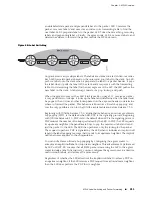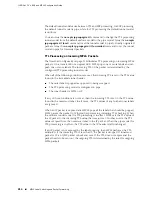
■
A spoof check field that specifies the type of spoof checking is performed to
determine whether the MPLS packet arrived from a legitimate source. See “Spoof
Checking MPLS Packets” on page 225 for more information.
Related Topics
■
See Monitoring MPLS on page 315, for information about enabling statistics
collection for MPLS forwarding table entries.
■
MPLS Label Switching and Packet Forwarding on page 209
■
MPLS Label Distribution Methodology on page 218
■
Spoof Checking MPLS Packets on page 225
■
IP and IPv6 Tunnel Routing Tables and MPLS Tunnels on page 225
Spoof Checking MPLS Packets
The MPLS forwarding table enables MPLS to determine whether an MPLS packet
received from an upstream neighbor contains an MPLS label that was advertised to
that neighbor. If not, the packet is dropped. Each entry in the forwarding table has
a spoof check field that specifies the type of checking that must be performed for
the associated in label. The signaling protocol (BGP, LDP, or RSVP) that populates
the entry in the MPLS forwarding table sets the spoof check field.
MPLS supports the following types of spoof checking:
■
Router spoof checking—MPLS packets are accepted only if they arrive on an
MPLS major interface that is in the same virtual router as the MPLS forwarding
table.
■
Interface spoof checking—MPLS packets are accepted only if they arrive on the
particular MPLS major interface identified in the spoof check field.
You can use the
show mpls forwarding
command to view the spoof check field for
an MPLS forwarding table entry.
Related Topics
■
MPLS Forwarding and Next-Hop Tables on page 224
IP and IPv6 Tunnel Routing Tables and MPLS Tunnels
The IP and IPv6 tunnel routing tables contain routes that point only to tunnels, such
as MPLS tunnels. The tunnel routing table is not used for forwarding. Instead, protocols
resolve MPLS next hops by looking up the routes in the table. For example, BGP uses
the table to resolve indirect next hops for labeled routes.
BGP, LDP, and RSVP-TE can contribute routes to the table. LDP adds all destinations
that can be reached by means of labels learned from downstream LDP neighbors.
RSVP-TE adds only MPLS tunnel endpoints. BGP also adds routes to the tunnel table
in certain cases. Routes added by any of these protocols include the effective metric.
Spoof Checking MPLS Packets
■
225
Chapter 2: MPLS Overview
Summary of Contents for BGP
Page 6: ...vi ...
Page 8: ...viii JUNOSe 11 1 x BGP and MPLS Configuration Guide ...
Page 37: ...Part 1 Border Gateway Protocol Configuring BGP Routing on page 3 Border Gateway Protocol 1 ...
Page 38: ...2 Border Gateway Protocol JUNOSe 11 1 x BGP and MPLS Configuration Guide ...
Page 234: ...198 Monitoring BGP JUNOSe 11 1 x BGP and MPLS Configuration Guide ...
Page 236: ...200 Multiprotocol Layer Switching JUNOSe 11 1 x BGP and MPLS Configuration Guide ...
Page 542: ...506 Monitoring BGP MPLS VPNs JUNOSe 11 1 x BGP and MPLS Configuration Guide ...
Page 544: ...508 Layer 2 Services Over MPLS JUNOSe 11 1 x BGP and MPLS Configuration Guide ...
Page 610: ...574 Virtual Private LAN Service JUNOSe 11 1 x BGP and MPLS Configuration Guide ...
Page 624: ...588 VPLS References JUNOSe 11 1 x BGP and MPLS Configuration Guide ...
Page 680: ...644 Virtual Private Wire Service JUNOSe 11 1 x BGP and MPLS Configuration Guide ...
Page 724: ...688 Monitoring MPLS Forwarding Table for VPWS JUNOSe 11 1 x BGP and MPLS Configuration Guide ...
Page 725: ...Part 6 Index Index on page 691 Index 689 ...
Page 726: ...690 Index JUNOSe 11 1 x BGP and MPLS Configuration Guide ...
















































